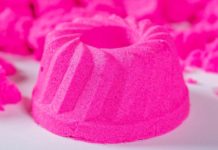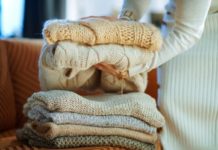 “Testers in Essex, Massachusetts, rub a dryer sheet on a leg to determine whether it prevents greenhead fly bites. That’s just one of the many uses people have found for dryer sheets. Keith Bedford/The Boston Globe via Getty Images
“Testers in Essex, Massachusetts, rub a dryer sheet on a leg to determine whether it prevents greenhead fly bites. That’s just one of the many uses people have found for dryer sheets. Keith Bedford/The Boston Globe via Getty Images
Many people routinely toss a dryer sheet or two into their dryers before pressing the start button. That’s because these small, papery sheets reduce static cling and wrinkles, soften your duds, and leave them with a pleasing, fresh scent. But dryer sheets are typically thrown in the trash once the clothes are dried. That’s a shame, because they can be repurposed to perform a wide variety of other tasks.
Dryer sheets are stiff, woven pieces of fiber, generally about 9 inches (22 centimeters) long and 6.4 inches (16 centimeters) wide. They’re coated with fabric softeners and lubricants as well as a scent like lavender, linen, musk or rain. Some sheets are also sold unscented.
When you start your dryer, these sheets do their magic when the coating melts off them and onto your clothing as they all tumble together, leaving your laundry soft and free of static. Afterward, the dryer sheets are ready for their second incarnation.
Here are 16 ways you can recycle and reuse your old dryer sheets. Some of these hacks are for new sheets, too.
Regular Cleaning
That coating that dryer sheets come with is useful for picking up dust and dirt. Here are some things you can use dryer sheets for as you clean.
- Dust almost anything. Take an old dryer sheet and use it as a dust cloth, running it over items such as window blinds, baseboards, ceiling fan blades and your car’s dashboard. Bonus: The sheets are great at picking up pet hair in the process, and any coating still on them will also help the surface you’ve just cleaned repel dust and lint.
- Wipe up spills. Spilled some flour, baking soda or seasoning? Dryer sheets are great at cleaning up such messes, as dry ingredients will stick to the sheets. But don’t use them when you’ve spilled something on the floor, as they can make it quite slick and a slipping hazard.
- Remove sap and sand. When you’re in the great outdoors, use old dryer sheets to remove tree sap from your hands — it sticks to a dryer sheet better than a wet wipe — and to easily brush sand from your feet and legs.
Tough Cleaning
- Scrub pots and pans. Dryer sheets are great at tackling the hard stuff. Take dirty pots and pans. If you’re not in the mood to vigorously scrub them for an indefinite amount of time, fill the pot or pan with hot water, toss in a new dryer sheet and let it soak at least an hour or overnight. In the morning, the sheet will have helped loosen the crusty food so you can more easily wipe it off.
- Remove grime from oven racks. If your oven racks become grimy — a common occurrence — fill your bathtub with warm water, a half-cup of dish soap and eight new dryer sheets. Then lower in the racks and let them soak overnight. In the morning, scrub off the gunk with the dryer sheets, then rinse, dry and replace in your oven.
- Clean crusty irons. Dryer sheets work well if you need to clean the bottom of your iron, where residue can accumulate from spray starch buildup and even melted synthetic fabrics.
- Remove soap scum. Unfortunately, it’s easy to discover a film of soap on your shower door or bathtub. Scrub clean with a used dryer sheet.
Deodorizing
If you’ve got scented sheets on hand, either new or just out of the dryer, they can be used to make any number of household items smell more pleasant. In general, it’s better to use new sheets for deodorizing, as their scent is stronger.
- Freshen wastebaskets and vacuum cleaners. Toss a dryer sheet in the bottom of your wastebasket before adding the bag, or in your vacuum cleaner to combat unpleasant smells.
- Refresh camping gear. Even outdoorsy people don’t enjoy unpleasant smells. Before you pack away your camping equipment, toss dryer sheets into items like your tent, sleeping bag and backpack. They’ll smell much better the next time you use them.
- Get rid of car odors. Tuck a few dryer sheets under your front seats and you may be able to get rid of that pine tree deodorizer hanging from your rearview mirror.
- Freshen up workout gear. Stick dryer sheets into your gym shoes and gym bags to keep nasty smells at bay.
- Remove stale odors from your suitcase. Travelers should place dryer sheets in their suitcases to avoid the stale smells that can develop when they’re closed up for a while.
- Eliminate smells in your home. If a room in your house smells a little funky, tape a dryer sheet to the back of a vent or two so that the air flowing through them will pick up their pleasant scent. If you do this, though, make sure to replace the sheets weekly so no dusty build-up will impede the air flow.
Miscellaneous
Bet you never thought of using your dryer sheets for the following:
- De-squeak shoes. Have a squeak in your shoe due to orthotics or insoles that are rubbing against the bottom? Place a new or used dryer sheet in between the bottom of the shoe and the orthotic or insole, and the squeak will disappear. If it comes back, it may be because the sheet has slipped out of place; simply readjust. Or it may be time for a new sheet.
- Sharpen scissors. Scissors dull? Then use them to cut up a dryer sheet or two and that should restore some of their cutting ability.
- Repel insects. If you enjoy hiking but flying insects keep circling your head, tuck a new dryer sheet into the back of your ball cap, leaving several inches hanging out. Both the scent of the sheet and its movement as you walk may keep insects at bay. (Studies have shown that linalool, a popular floral-scented chemical in cosmetics, perfumes and dryer sheets, repels fungus gnats and some types of weevils. But linalool didn’t seem to have much value at repelling mosquitoes.)
Now That’s Bogus
You may come across some alarming blog posts that claim dryer sheets contain toxic chemicals such as chloroform and benzyl alcohol, which can interfere with your body’s hormonal regulation and even cause cancer. But the ingredients these blogs commonly list as toxic aren’t found in dryer sheets. And even if they were, the Food and Drug Administration generally categorizes them as safe.








































